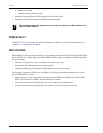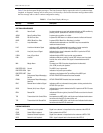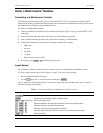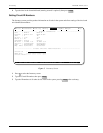
Installation LTPH-UM-1109-01, Issue 1
8 January 9, 2002 H2TU-C-231 List 2
VERIFICATION
Once the H2TU-C-231 is installed, verify that it is operating properly. To do this, monitor the following:
• Status LED (see Figure1onpage3)
• Status messages reported by the front-panel display (see Table 2 on page 5)
Verification without an H2TU-R Remote Unit
If there is no H2TU-R remote unit installed:
1 Verify that the H2TU-C powers up. The front-panel display illuminates and reports status messages. (See
Table 2 on page 5 for a list of messages.)
2 Verify that the H2TU-C attempts to communicate with a remote unit (status LED flashes red). Even if a
remote unit is not present, the following events should occur:
a The front-panel display reports various four-character status messages.
b The H2TU-C again attempts communication until a remote unit is detected.
Verification with an H2TU-R Remote Unit
If an H2TU-R remote unit has been installed:
1 Verify that the H2TU-C powers up. (The front-panel display illuminates and reports various status messages.)
2 Verify that the H2TU-C attempts to communicate with the remote unit (status LED flashes red). One of the
following occurs:
a If the remote unit is successfully identified and the HDSL2 loop synchronizes, the H2TU-C status LED
lights a steady green. The H2TU-C reports normal margin messages on the front-panel display.
b If the remote unit is not identified, the H2TU-C reports four-character status messages. The H2TU-C
attempts communication again and reports four-character status messages. The H2TU-C repeats this
cycle until a remote unit is detected.
3 Verify that a valid DS1 signal has been applied to the H2TU-C and the H2TU-R.
a If no DS1 signal is being applied to either the H2TU-C or the H2TU-R inputs, then the appropriate DS1
alarms (LLOS or RLOS) display on the front panel and the status LED flashes red.
b If a valid DS1 signal is being supplied to the H2TU-C and H2TU-R, then DS1 alarm indications should
be absent and the status LED should be a steady green.


















